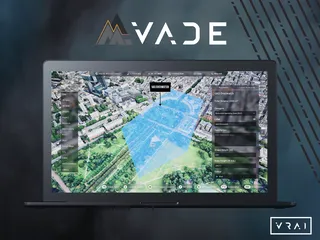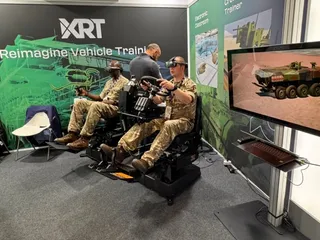Snapshot: The Journey to Advance AI for Military Learning Audiences
Contact Our Team
For more information about how Halldale can add value to your marketing and promotional campaigns or to discuss event exhibitor and sponsorship opportunities, contact our team to find out more
The Americas -
holly.foster@halldale.com
Rest of World -
jeremy@halldale.com

Defense leaders in the Pentagon and elsewhere around globe envision AI will support most of their services’ and agencies’ day-to-day business and operational activities – from intelligence to logistics to missions in the warfare domains. The consequences are immense for the department’s learning enterprises. While AI may be viewed by some as a “mid tech” or “so-so” technology as it trains logisticians to complete laser-sharp inventories and like tasks, artificial intelligence is also being developed literally for life-and-death purposes – training operators to successfully unleash kinetic and non-kinetic effects in missions.
This is another in a series of MS&T articles to support Halldale Group’s overarching focus on AI for high-risk training enterprises. We look forward to providing future content in this department to supplement our podcasts.
Definition and Framework
But first, a definition of AI for this discussion. During one attention-getting, recent presentation the author attended during WATS 2025. Samuel Chandra, CEO at deepsky, told the delegates, in part, AI is “software that exhibits intelligence” – a definition that also fits the military use case quite well.
As another data point, industry-military teams are in the formative stages of developing and using AI for learning in defense forces in and beyond the US. Len Granowetter, CTO at MAK, initially told MS&T, that we’re still very much in the early adoption stage. “In our experience, even though end users are asking for this kind of tech, most of the actual investment and activity has been on the R&D side. A lot of the work we’ve done, whether through bids or R&D collaborations, has been focused on exploring what’s possible. That said, the interest is definitely there. The market is trying to move in that direction—it just needs the right tools and platforms to learn from.”
Two teams engaged in this journey at this technology’s formative stage shared their insights with this author and provided their early successes, challenges and opportunities to create a robust AI capability for military learning enterprises.
Highest Levels of Attention
Canada’s Department of National Defence (DND) views using AI for Talent and Training as one of the five lines of effort in its DND/CAF (Canadian Armed Forces) Artificial Intelligence Strategy. Jay Ballard, Vice President Defence – Learning, Calian Ltd., noted the AI Strategy also identified training and simulation as an AI Capability with specific mentions of: virtual wargaming; digital twins; and virtual reality training. The executive pointed out the early mentions of AI reflected military leaders knew they needed to leverage the capability. But without extensive experience with the technology, they were unable to get too prescriptive with ways to use it. “That left it up to the defense industry to develop solutions.” Of no surprise, there is a frenetic pace to provide efficient and effective use cases for AI in military learning programs.
Several Use Cases in Defense Learning
Ballard noted the Calian team has had several discussions with the military community about using AI to assist with training and education. “AI is being leveraged by many companies, including Calian, to help automate training and education development with extensive work being done in that area,” he explained and particularly noted, “some of the most exciting applications that really leverage AI is with real time feedback of training effectiveness. Students who quickly master a skill can be advanced ahead of their peers - reducing their time to competency. Those progressing at a slower pace will get to perfect skills before moving on to more advanced areas, which increases their chances of successfully finishing training. Using AI in this manner makes training a personalized experience, more efficiently delivered instead of the entire cadre having to move at the average pace.”
One representative technology thrust in the AI for learning space finds MaestroEDE as an exercise design, development and delivery tool created by Calian, helping Canadian military training specialists deliver complex training events. Training objectives, determined by the military, drive the overall design of the exercise inside the MaestroEDE ecosystem, Ballard said and further explained, “The development of events and injects, along with orders and supporting documents, is supported by our integrated AI assistant which can make development faster and richer with more detailed content and more possible tests for the training audience. Development and delivery can be distributed to several locations and centrally orchestrated, which saves travel and lodging expenses. Training audience performance can be captured for after-action reviews and debriefs supported with data analytics from some of our other tools.”
MAK’s Granowetter opened the aperture a bit further on military training enterprises’ vision for AI.
The executive first noted another of the biggest early expectations has been using AI to make training more realistic and efficient by making computer-generated forces a lot smarter – adding intelligence to simulated enemies (opfor) so trainees get a more dynamic and challenging experience. This will have the added benefit of reducing the amount of manpower needed to run large exercises. Granowetter explained, “Another area is using AI to reduce the number of human instructors needed to run a training session. With AI technologies like MAK’s NICO, the idea is that a virtual instructor could guide the trainee through the training experience, so there’s less need for someone to be present and actively managing the scenario. That shift to having fewer instructors required to run each session is where AI can make a difference.”
Collaboration
As we’ll see elsewhere in the AI for military learning sector, Calian is optimizing industry collaboration to advance its portfolio. Ballard provided one attention-getter when he recalled, “When we first started our work on integrating a large language model within MaestroEDE, we wanted to do so by leveraging our relationships with some key AI developers. We viewed this as a way to reduce risk and speed integration of the AI within MaestroEDE. We participated in two Microsoft AI Sprints over a year and a half and they were invaluable to the rapid integration of AI capabilities into our existing solutions."
For its part, MAK has partnered with Boston Fusion, a small tech company that specializes in AI/ML and Deep Reinforcement Learning (DRL), on an Army SBIR for a multi-domain C2 Reinforcement Learning Training Environment (called MUD CRANE). Boston Fusion integrated its DRL agent with VR-Forces to perform course of action analysis. In the system, the AI examines a VR-Forces scenario and its objectives, and from that, determines the best way to achieve the mission objectives. “Running VR-Forces simulations faster than real time allows the DRL agent to test multiple approaches and learn from the different outcomes, ultimately training its AI models to predict and refine the best tactical decisions efficiently,” the CTO recalled.
As part of its Group’s R&D efforts to transform emerging technologies into practical solutions, ST Engineering integrated Agentic AI with MAK’s VR-Forces. The MAK executive further explained the AI allows users to: input high-level objectives using natural language; interpret the objectives; extract scenarios in VR-Forces; and use generative AI for tasking entities within VR-Forces to execute its mission.
And beyond the US, MAK is involved in the UK Army FORGE program, which is using AI to automate the defense experimentation process. “FORGE, led by an innovative UK company, Cervus, integrates the UK’s defense experimentation process with VR-Forces. Large language Models (LLMs) are used to extract and summarize relevant doctrine and research documentation to provide AI-based course of action analysis. FORGE is going into the 2nd year of a three-year program, and we are excited to see how far Cervus can go,” Granowetter said.
Early Outcomes and Lessons Learned
While Granowetter offered that for most of the industry it’s a bit early to talk ROI in a traditional sense, MAK is seeing some really valuable outcomes from its early work. “For example, in our work with the Marine Corps Immersive Training Environment (ITE) Program, we’ve developed AI-based tech that can eventually replace instructors in live training exercises. That’s been our main focus, but through those efforts, especially in our development and discussions around NICO, we’ve started uncovering other use cases.”
Elsewhere, MAK is seeing potential applications in things like maintenance trainers or AI assistants that help users operate complex training systems. “One of the biggest takeaways so far is that by building AI tech for a specific use case, we’re revealing all sorts of new opportunities for where it can go next,” the CTO said.
Lawrence Elliott, Deputy Director of MAK Simulation Solutions, followed up on the point about the example of new AI opportunities that arise. “I want to emphasize NICO, which we have been traditionally using as a visual avatar to see and interact with during a training exercise. Recently we’ve been exploring using NICO in what we call ‘headless mode’ — meaning without an avatar—and its use as an AI-driven simulated agent integrated within MAK ONE’s VR-Forces,” the deputy director commented and again reiterated this capability significantly reduces the requirement for human personnel to manually control simulated entities, including opposing forces, blue forces and neutral forces. “By using AI to autonomously manage these units, training exercises become more efficient, scalable and realistic, enabling personnel to focus on higher-level strategic and analytical tasks rather than manual simulation control.”
A more concrete ROI offered by MAK can be seen in the FORGE program. A rapid analysis, which would normally take 9-12 weeks, has been completed in less than 24 hours, providing the UK Army staff with near real-time forces structure performance feedback.
Following this Early Adoption Journey
Industry-defense teams industry teams are demonstrating AI’s early potential to provide different solutions to training and education challenges. MS&T will be following these activities in the global military community. Practitioners in this learning space are invited to reach out to the author at marty.kauchak@halldale.com to keep us updated on your activities and plans to further mature AI as a technology enabler.


